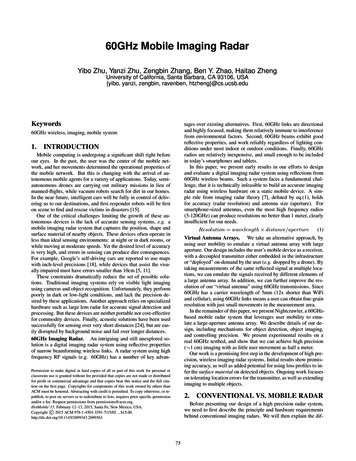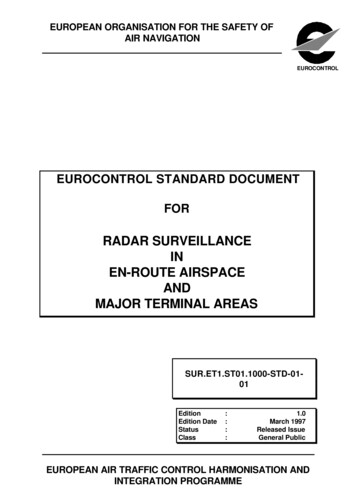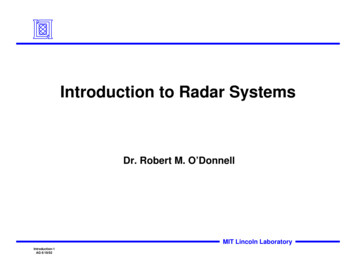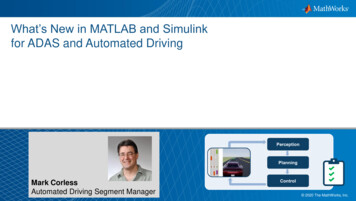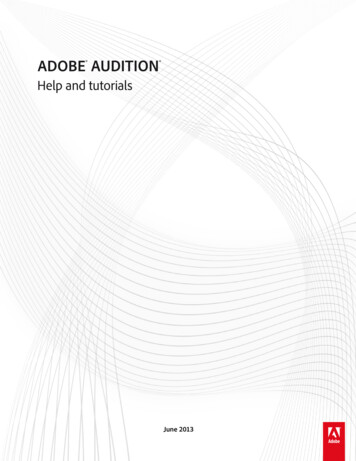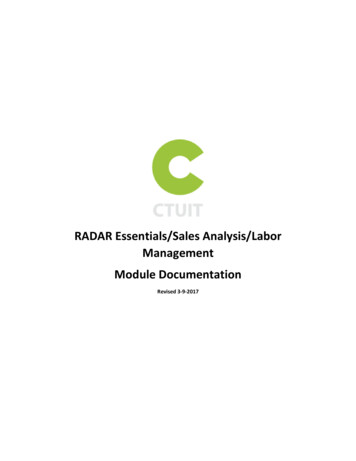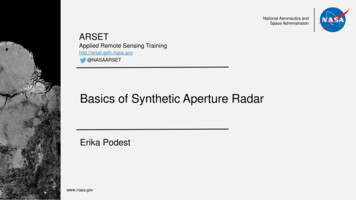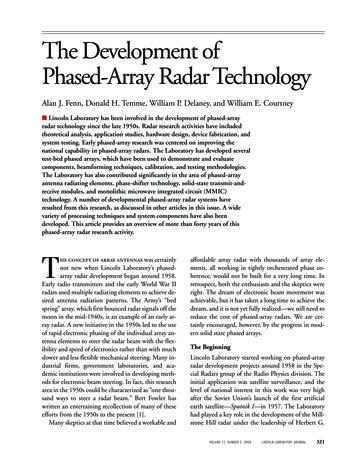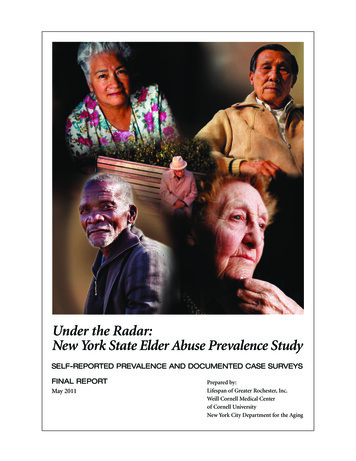
Transcription
Under the Radar:New York State Elder Abuse Prevalence StudySELF-REPORTED PREVALENCE AND DOCUMENTED CASE SURVEYSFINAL REPORTMay 2011Prepared by:Lifespan of Greater Rochester, Inc.Weill Cornell Medical Centerof Cornell UniversityNew York City Department for the Aging
TABLE OF CONTENTSResearch Project Participants . . . . . . . . . . . . . . . . . . . . . . . . . . . . . . . . . . . . . . . . . . . . . . . . . . . . . . . . . .iiiAdvisory Committee . . . . . . . . . . . . . . . . . . . . . . . . . . . . . . . . . . . . . . . . . . . . . . . . . . . . . . . . . . . . . . . . .ivAcknowledgements . . . . . . . . . . . . . . . . . . . . . . . . . . . . . . . . . . . . . . . . . . . . . . . . . . . . . . . . . . . . . . . . . . .vExecutive Summary . . . . . . . . . . . . . . . . . . . . . . . . . . . . . . . . . . . . . . . . . . . . . . . . . . . . . . . . . . . . . . . . . . .1Introduction . . . . . . . . . . . . . . . . . . . . . . . . . . . . . . . . . . . . . . . . . . . . . . . . . . . . . . . . . . . . . . . . . . . . . . . .7Background . . . . . . . . . . . . . . . . . . . . . . . . . . . . . . . . . . . . . . . . . . . . . . . . . . . . . . . . . . . . . . . . . . . . . . . . .7Elder Abuse Defined . . . . . . . . . . . . . . . . . . . . . . . . . . . . . . . . . . . . . . . . . . . . . . . . . . . . . . . . . . . . . . . . . .8Impetus for the Study . . . . . . . . . . . . . . . . . . . . . . . . . . . . . . . . . . . . . . . . . . . . . . . . . . . . . . . . . . . . . . . .10Significance of the Study . . . . . . . . . . . . . . . . . . . . . . . . . . . . . . . . . . . . . . . . . . . . . . . . . . . . . . . . . . . . . .10Previous Studies and Surveys of Prevalence and Documented Cases . . . . . . . . . . . . . . . . . . . . . . . . .11New York State Demographics . . . . . . . . . . . . . . . . . . . . . . . . . . . . . . . . . . . . . . . . . . . . . . . . . . . . . . . . .13Research Partners . . . . . . . . . . . . . . . . . . . . . . . . . . . . . . . . . . . . . . . . . . . . . . . . . . . . . . . . . . . . . . . . . . . .14Research Challenges . . . . . . . . . . . . . . . . . . . . . . . . . . . . . . . . . . . . . . . . . . . . . . . . . . . . . . . . . . . . . . . . .15Elder Abuse Services in New York State . . . . . . . . . . . . . . . . . . . . . . . . . . . . . . . . . . . . . . . . . . . . . . . . .16MethodologyPrevalence (Self-Reported) Study . . . . . . . . . . . . . . . . . . . . . . . . . . . . . . . . . . . . . . . . . . . . . . . . .17Documented Case Study . . . . . . . . . . . . . . . . . . . . . . . . . . . . . . . . . . . . . . . . . . . . . . . . . . . . . . . .22ResultsSelf-Reported Cases . . . . . . . . . . . . . . . . . . . . . . . . . . . . . . . . . . . . . . . . . . . . . . . . . . . . . . . . . . . .24Documented Cases . . . . . . . . . . . . . . . . . . . . . . . . . . . . . . . . . . . . . . . . . . . . . . . . . . . . . . . . . . . . .36Comparison of Self-Reported and Documented Case Data . . . . . . . . . . . . . . . . . . . . . . . . . . . . . . . . .50Conclusions . . . . . . . . . . . . . . . . . . . . . . . . . . . . . . . . . . . . . . . . . . . . . . . . . . . . . . . . . . . . . . . . . . . . . . . .54Limitations of the Study . . . . . . . . . . . . . . . . . . . . . . . . . . . . . . . . . . . . . . . . . . . . . . . . . . . . . . . . . . . . . .58Implications for Further Research . . . . . . . . . . . . . . . . . . . . . . . . . . . . . . . . . . . . . . . . . . . . . . . . . . . . . .58References . . . . . . . . . . . . . . . . . . . . . . . . . . . . . . . . . . . . . . . . . . . . . . . . . . . . . . . . . . . . . . . . . . . . . . . . . .59AppendicesA – Self-Reported Study Questionnaire . . . . . . . . . . . . . . . . . . . . . . . . . . . . . . . . . . . . . . . . . . . .61B – Documented Case Study Survey . . . . . . . . . . . . . . . . . . . . . . . . . . . . . . . . . . . . . . . . . . . . . . .77C – Documented Case Study Aggregate Case Data by Region . . . . . . . . . . . . . . . . . . . . . . . . . .94D – Documented Case Study Data by Region – Discussion . . . . . . . . . . . . . . . . . . . . . . . . . . .100E – Documented Case Study Aggregate Data by Service System . . . . . . . . . . . . . . . . . . . . . . .115F – Documented Case Study Service System Data – Discussion . . . . . . . . . . . . . . . . . . . . . . .118FiguresFigure 1 – New York State Resident Population- 60 years of age . . . . . . . . . . . . . . . . . . . . . .13Figure 2 – Map of New York State Regions . . . . . . . . . . . . . . . . . . . . . . . . . . . . . . . . . . . . . . . . .26TablesTable 1 – Self-Reported Study-Marital Status of Respondents . . . . . . . . . . . . . . . . . . . . . . . . .25Table 2 – Self-Reported Study-Ethnicity of Respondents . . . . . . . . . . . . . . . . . . . . . . . . . . . . .25Table 3 – Self-Reported Study-Household Income . . . . . . . . . . . . . . . . . . . . . . . . . . . . . . . . . .25Self Reported Prevalence and Documented Case SurveysFinal Report 2011 i
Table 4 – Respondent and Elder Population Distribution by Region . . . . . . . . . . . . . . . . . . .27Table 5 – Prevalence Rates of Self-Reported Elder Abuse in New York Stateby Mistreatment Domain . . . . . . . . . . . . . . . . . . . . . . . . . . . . . . . . . . . . . . . . . . . . . .28Table 6 – Prevalence Rates of Self-Reported Elder Abuse in New York Stateby Geographic Area . . . . . . . . . . . . . . . . . . . . . . . . . . . . . . . . . . . . . . . . . . . . . . . . . . .29Table 7 – Incidence Rates of Self-Reported Elder Abuse in New York Stateby Mistreatment Domain . . . . . . . . . . . . . . . . . . . . . . . . . . . . . . . . . . . . . . . . . . . . . .31Table 8 – Incidence Rates of Self-Reported Elder Abuse in New York Stateby Geographic Area . . . . . . . . . . . . . . . . . . . . . . . . . . . . . . . . . . . . . . . . . . . . . . . . . . .33Table 9 – Self-Reported Study-Number of Abusers in Individual Cases . . . . . . . . . . . . . . . . .34Table 10 – Self-Reported Study-Distribution of Abusers by Relationshipand Type of Mistreatment . . . . . . . . . . . . . . . . . . . . . . . . . . . . . . . . . . . . . . . . . . . . . .35Table 11 – Documented Case Study: Response Rate by Service Systemand Organization . . . . . . . . . . . . . . . . . . . . . . . . . . . . . . . . . . . . . . . . . . . . . . . . . . . . .37Table 12 – Documented Case Study: Response Rate by Region . . . . . . . . . . . . . . . . . . . . . . . . .38Table 13 – Rates of Documented Elder Abuse in New York Stateby Geographic Area . . . . . . . . . . . . . . . . . . . . . . . . . . . . . . . . . . . . . . . . . . . . . . . . . . .39Table 14 – Documented Case Data –All Service Systems Statewide-Victim Information . . . . . . . . . . . . . . . . . . . . . . . . . .42Table 15 – Documented Case Data –All Service Systems Statewide-Abuser Information . . . . . . . . . . . . . . . . . . . . . . . . .44Table 16 – Documented Case Data –All Service Systems Statewide-Referral Information . . . . . . . . . . . . . . . . . . . . . . . . .46Table 17 – Documented Case Study Data-Percent of OrganizationsProviding Victim Information by Service System . . . . . . . . . . . . . . . . . . . . . . . . . . .49Table 18 – Rates of Elder Abuse in New York State: Comparison of Self-ReportedOne-Year Incidence and Documented Case Data . . . . . . . . . . . . . . . . . . . . . . . . . . .50Table 19 – Comparison of Self-Reported One-Year Incidence andDocumented Case Rates of Elder Abuse by Geographic Area . . . . . . . . . . . . . . . . .52Table 20 – Victim Demographic Information: Comparison of Documented Case Dataand Self-Reported Data . . . . . . . . . . . . . . . . . . . . . . . . . . . . . . . . . . . . . . . . . . . . . . . .53Prepared for:William B. Hoyt Memorial New York State Children and Family Trust FundNew York State Office of Children and Family Servicesii U n d e r t h e R a d a r : N e w Yo r k S t a t e E l d e r A b u s e P r e v a l e n c e S t u d y
RESEARCH PROJECT PARTICIPANTSPrincipal InvestigatorsResearch ConsultantsMark Lachs, MD, MPHIrene F. and I. Roy PsatyDistinguished Professor of MedicineWeill Cornell Medical CollegeDirector of GeriatricsNew York Presbyterian Healthcare SystemPatricia Brownell, PhD, LMSWResearch ConsultantAssociate Professor Emerita of Social ServiceFordham UniversityJacquelin Berman, PhDDirector of ResearchNew York City Department for the AgingCharles Henderson, PhDSenior Research AssociateCollege of Human EcologyCornell UniversityYasamin Miller, MSDirectorCornell Survey Research InstituteCornell UniversityProject TeamPaul L. Caccamise, LMSW, ACSWProject DirectorVice President for ProgramLifespan of Greater RochesterAnn Marie Cook, MPAPresident/CEOLifespan of Greater RochesterArt Mason, LMSWAssistant Project DirectorProgram ManagerElder Abuse Prevention ProgramLifespan of Greater RochesterResearch AssistantsMikelle Damassia, MPAResearch AssistantFordham UniversityMebane Powell, MSWResearch AssociateNew York City Department for the AgingAurora Salamone, MPSDirector, Elderly Crime Victims Resource CenterNew York City Department for the AgingDenise Shukoff, JDProject CoordinatorSpecial Projects CoordinatorLifespan of Greater RochesterSelf Reported Prevalence and Documented Case SurveysFinal Report 2011 iii
PROJECT ADVISORY COMMITTEEAmy Barasch, New York State Office for the Prevention of Domestic ViolencePatricia Bomba, Excellus BlueCross BlueShield; MedAmerica Insurance Co. of NYRisa Breckman, Weill Cornell Medical CollegeAndrea Hoffman, New York State Office for the AgingPatricia Jennings, New York City Adult Protective ServicesGavin Kasper, Erie County Department of Social ServicesGary Kelly, New York State PoliceKaren Kissinger, New York State Office of Children & Family Services, Children & Family Trust FundAlan Lawitz, New York State Office of Children & Family Services, Bureau of Adult ServicesElizabeth Loewy, New York County District Attorney’s OfficeKen Onaitis, Carter Burden Center for the AgingKarl Pillemer, Cornell UniversityJudy Richards, New York State Office of Children & Family Services, Children & Family Trust FundElizabeth Santos, University of Rochester Medical CenterMarcie Serber, New York State Unified Court SystemJoy Solomon, Weinberg Center for Elder Abuse Prevention at the Hebrew HomeKim Spoonhower, New York State Office of Victim ServicesGwen Wright, New York State Office for the Prevention of Domestic Violenceiv U n d e r t h e R a d a r : N e w Yo r k S t a t e E l d e r A b u s e P r e v a l e n c e S t u d y
ACKNOWLEDGEMENTShis study was the result of a team effort involving not only the research partners but also manyexperts, academic institutions, social service organizations and government agencies in New YorkState. The study partners would like to acknowledge the indispensable contributions made by manycolleagues. In particular, we would like to thank the Project Advisory Committee for their input into the designof the study. Special recognition is in order for Yasamin Miller, Director, and Darren Hearn, Manager, and theexceptional staff of the Cornell Survey Research Institute for conducting over 4,300 telephone interviews witholder New Yorkers.TWe thank Karl Pillemer and Charles Henderson of Cornell University for their expert input throughoutthe project. We are grateful to the many organizations that responded to the Documented Case Survey and tothe officials who facilitated access to critical data. We would also like to thank Mebane Powell, ResearchAssociate, New York City Department for the Aging, and Mickelle Damassia, Research Assistant, FordhamUniversity Graduate School of Social Service, for their diligent work in collecting and analyzing data from over400 surveys collected from agencies across New York State.Special thanks are also due to Alan Lawitz, Director, Bureau of Adult Services, New York State Office ofChildren and Family Services, and his staff for assistance in accessing and interpreting Adult Protective Servicesdata for New York State. In particular, we would like to recognize OCFS Division of IT staff, Sandra Carrk andJennifer Gordon, as well as former IT consultant, Asha Ramrakhiani. We would also like to thank Assistant ChiefKathy Ryan of the New York City Police Department, Adrianna Fernandez-Lanier of the NYS Division of CriminalJustice Services, Kim Spoonhower from the NYS Office of Victim Services and Andrea Hoffman of the NYS Officefor the Aging for their invaluable assistance in obtaining data about elder abuse from their respective agencies.We would like to express our appreciation to the New York State Office of Children and Family Services/William B. Hoyt Memorial New York State Children and Family Trust Fund for sponsoring the project. Specialthanks are due to Judy Richards, Trust Fund Director, and Karen Kissinger, Trust Fund Program Manager, forshepherding the project through the state funding process and for their contributions to planning in all phasesof the study. We are grateful to the support staff at the participating institutions at Lifespan, Weill CornellMedical College, New York City Department for the Aging and Fordham University, all of whom had a hand inrealizing the goals of the study.We would also like to give special thanks to all the organizations that worked with us to gather data andrespond to our questionnaire.Finally, the research partners would like to thank the many older adults in New York who shared theirtime with us and revealed private life experiences with us in telephone interviews for the purpose of sheddinglight on the often hidden problem of elder abuse.Self Reported Prevalence and Documented Case SurveysFinal Report 2011 v
NEW YORK STATE ELDER ABUSE PREVALENCE STUDYEXECUTIVE SUMMARYhe New York State Elder Abuse Prevalence Study is one of the most ambitious and comprehensivestudies to quantify the extent of elder abuse in a discrete jurisdiction ever attempted, and certainlythe largest in any single American state. With funding from the New York State William B. HoytMemorial Children and Family Trust Fund, a program administered under NYS Office of Children and FamilyServices, three community, governmental, and academic partners (Lifespan of Greater Rochester, the New YorkCity Department for the Aging and the Weill Cornell Medical College) formed a collaborative partnership toconduct the study.TAIMS OF THE STUDYThe study had three central aims achieved through two separate study components: To estimate the prevalence and incidence of various forms of elder abuse in a large, representative,statewide sample of older New Yorkers over 60 years of age through direct interviews (hereafterreferred to as the Self-Reported Prevalence Study) To estimate the number of elder abuse cases coming to the attention of all agencies and programsresponsible for serving elder abuse victims in New York State in a one-year period (the DocumentedCase Study), and To compare rates of elder abuse in the two component studies, permitting a comparison of “known”to “hidden” cases, and thereby determining an estimate of the rate of elder abuse underreporting inNew York State.Prevalence refers to the number of older adults who have ever experienced elder mistreatment since turning60. Incidence refers to the number of new cases of elder abuse in the year prior to the survey interview.METHODOLOGYAt the completion of the study, 4,156 older New Yorkers or their proxies had been interviewed directly and 292agencies reported on documented cases from all corners of the state. Through the collaborative efforts of thethree research partners, the study employed “cutting edge” methodologies to accomplish the goals of the study.These included (1) improvement of existing survey instruments to make them “state of the art” using thecombined field knowledge of academics and direct service providers; separate surveys were created for the SelfReported Prevalence Survey and the Documented Case Study, (2) utilization of the Cornell Research SurveyInstitute in Ithaca to assemble a representative state sample of older adults and to conduct the interviews bytelephone, (3) administration of a survey to all major service systems, agencies and programs in the state thatreceive reports of elder abuse and provide investigation and intervention to older adult victims.Self Reported Prevalence and Documented Case SurveysFinal Report 2011 1
Methodology - Self-Reported Prevalence StudyIn the Self-Reported Prevalence Study, the research team assembled a representative sample of all residents ofNew York State age 60 and older representing a broad cross section of the older population in the state. Thesample was created using a random digit dialing strategy derived from census tracts targeting adults over 60.The study was limited to older adults living in the community, that is, not living in licensed facilities such asnursing homes and adult care facilities. The actual surveys were conducted by telephone by trained interviewersat the Cornell Survey Research Institute. The survey instrument used for this component of the study capturedelder mistreatment in four general domains: (1) Neglect by a responsible caregiver (2) Financial Exploitation(3) Emotional Abuse and (4) Physical Elder Abuse (including Sexual Abuse).Methodology - Documented Case StudyThe Documented Case Study contacted programs and agencies responsible for specifically serving victims ofelder abuse and older victims of domestic violence in New York State and requested that they complete a surveyabout cases served in calendar year 2008. The survey included questions on elder abuse cases that mirrored thequestions used for the statewide Self-Reported Prevalence Study. Programs surveyed included Adult ProtectiveServices, law enforcement, area agencies on aging, domestic violence programs, elder abuse programs,programs funded by the Office of Victim Services (previously known as the Crime Victims Board), elder abusecoalitions, and District Attorney (DA) offices. While the amount of data supplied varied by county andorganization, at least some data was collected for each of the 62 counties in New York State.MAJOR FINDINGS The findings of the study point to a dramatic gap between the rate of elder abuse events reported by olderNew Yorkers and the number of cases referred to and served in the formal elder abuse service system. Overall the study found an elder abuse incidence rate in New York State that was nearly 24 timesgreater than the number of cases referred to social service, law enforcement or legal authorities whohave the capacity as well as the responsibility to assist older adult victims. Psychological abuse was the most common form of mistreatment reported by agencies providing dataon elder abuse victims in the Documented Case Study. This finding stands in contrast to the results ofthe Self-Reported Study in which financial exploitation was the most prevalent form of mistreatmentreported by respondents as having taken place in the year preceding the survey. Applying the incidence rate estimated by the study to the general population of older New Yorkers,an estimated 260,000 older adults in the state had been victims of at least one form of elder abuse inthe preceding year (a span of 12 months between 2008-2009).Caution must be exercised in interpreting the large gap between prevalence reported directly by olderadults and the number of cases served. The adequacy of some documentation systems to provide elder abusecase data may have played a role in the results. The inability of some service systems and individual programsto report on their involvement in elder abuse cases may have affected the final tally of documented cases. As a2 U n d e r t h e R a d a r : N e w Yo r k S t a t e E l d e r A b u s e P r e v a l e n c e S t u d y
result, an undetermined number of cases may not be accounted for from agencies and programs that could notaccess some data about elder abuse victims served. However, the study received comprehensive data from thelargest programs serving elder abuse victims: Adult Protective Services, law enforcement and community-basedelder abuse programs.Table ARates of Elder Abuse in New York State:Comparison of Self-Reported One-Year Incidence and Documented Case DataDocumentedRate per 1,000Self-reportedRate per 1,000Ratio of Self-Reportedto DocumentedNew York State - All forms of ical and *The Documented Case rate includes physical abuse cases only. Physical and sexual abuse data werecombined in the Self-Reported Study. The sexual abuse rate for the Documented Case Study was 0.03per 1,000.It should be noted that the sum of the rates exceeds the total rates in both the Documented Case and SelfReported Studies because some victims experienced more than one type of abuse.SELF-REPORTED PREVALENCE STUDYMajor findings of the Self-Reported Study include: A total one-year incidence rate of 76 per 1,000 older residents of New York State for any form of elderabuse was found. The cumulative prevalence of any form of non-financial elder mistreatment was 46.2 per thousandsubjects studied in the year preceding the survey. The highest rate of mistreatment occurred for major financial exploitation (theft of money orproperty, using items without permission, impersonation to get access, forcing or misleading to getitems such as money, bank cards, accounts, power of attorney) with a rate of 41 per 1,000 surveyed.This rate reflects respondent reports of financial abuse that occured in the year preceding the survey.(The rate for moderate financial exploitation, i.e. discontinuing contributions to household financesin spite of agreement to do so, constituted another 1 per 1,000 surveyed.) The study also found that 141 out of 1,000 older New Yorkers have experienced an elder abuse eventsince turning age 60.Self Reported Prevalence and Documented Case SurveysFinal Report 2011 3
DOCUMENTED CASE STUDYMajor findings of the Documented Case Study include: Adjusting for possible duplication of victims served by more than one program, the study determinedthat in a one-year period 11,432 victims were served throughout New York State, yielding a rate of3.24 elder abuse victims served per 1,000 older adults. Rates of documented elder abuse varied by region. The highest rate was in New York City (3.79 reportedcases per 1,000 older adult residents) compared to the region with the lowest rate of documentedcases, Central New York /Southern Tier (2.30 cases per 1,000). Variability in data collection across service systems contributed to the large gap uncovered between thenumber of cases reported through the Documented Case Study and the prevalence rates found in theSelf-Reported Study. The extent to which the gap can be attributed to data collection issues amongservice systems has not been established. While there was little difference among urban, suburban and rural counties in types of abuse reportedin the Documented Case Survey (for all regions, emotional abuse is the most common abuse categoryreported), urban areas tend to have higher documented case rates than rural counties.4 U n d e r t h e R a d a r : N e w Yo r k S t a t e E l d e r A b u s e P r e v a l e n c e S t u d y
Table BVictim Demographic InformationComparison of Documented Case Data and Self Reported DataDocumented Case StudyPercent of VictimsSelf-Reported StudyPercent of Victims60-6417.020.365-7441.938.075-8428.129.185 (Missing)13.80.0African American27.926.3Asian/Pacific 7.6Native American/Aleut Eskimo0.81.9Race, other10.52.9(Missing)50.81.9Information about victimsAge groupsGenderRace/EthnicityUnder Race/Ethnicity, it should be noted that in the Documented Case Study, some agencies permittedelder abuse victims to declare more than one ethnic category; as a result the sum of percentages exceeds 100. Inthe Self-Reported Study column, respondents who self identified as Hispanic/Latino in addition to anothercategory are reported in a separate statistic (7.6%). As a result, the sum of all categories again exceeds 100 percent.Note that in Table B, “Missing” in the Documented Case Study column indicates the percentage of casesin which responding organizations were unable to supply the data requested. In the Self-Reported Studycolumn, “Missing” indicates the percentage of telephone survey respondents who declined to supply therequested information.The comparison of demographic data in Table B reveals similar trends in both the Self-Reported andDocumented Case data except in the area of Race/Ethnicity. The percentage of Hispanic/Latino and Asian/PacificIslander victims served by Documented Case Study respondent organizations was approximately twice thepercentage of Self-Reported Study respondents who self-identified as Hispanic/Latino or Asian/Pacific Islander.On the other hand, Native Americans/Aleut Eskimos were represented in the Documented Case findings at lessthan half the rate they were found in the Self-Reported Study. It should also be noted, however, that respondingorganizations in the Documented Case Study were as a whole unable to provide racial/ethnic data in half ofthe cases.Self Reported Prevalence and Documented Case SurveysFinal Report 2011 5
CONCLUSIONSWhile the Prevalence Study did not attempt to analyze the reasons for the disparity in self-reported versusdocumented elder abuse, some possible explanations can be offered. Considerable variability in documentationsystems may play a role in the results. The Documented Case Study found a great deal of variability in the wayservice systems and individual organizations collect data in elder abuse cases. Some service systems and someregions may lack the resources to integrate elder abuse elements in data collection systems or may simply nothave an adequate elder abuse focus in their data collection. Population density, the visibility of older adults inthe community and, conversely, social isolation in rural areas may contribute to differences in referral rate trendsbased on geography. Greater awareness by individuals, both lay and professional, who have contact with olderadults and might observe the signs and symptoms of elder abuse, may also explain higher referral rates in some areas.The New York State Elder Abuse Prevalence Study uncovered a large number of older adults for whomelder abuse is a reality but who remain “under the radar” of the community response system set up toassist them.The findings of the New York State Elder Abuse Prevalence Study suggest that attention should be paid tothe following issues in elder abuse services: Consistency and adequacy in the collection of data regarding elder abuse cases across service systems.Sound and complete data sets regarding elder abuse cases are essential for case planning and programplanning, reliable program evaluation and resource allocation. Emphasis on cross-system collaboration to ensure that limited resources are used wisely to identify andserve elder abuse victims. Greater focus on prevention and intervention in those forms of elder abuse reported by elders to bemost prevalent, in particular, financial exploitation. Promotion of public and professional awareness through education campaigns and training concerningthe signs of elder abuse and the resources available to assist older adults who are being mistreated bytrusted individuals.IMPLICATIONS FOR FOLLOW UP AND FURTHER STUDYFor the first time, a scientifically rigorous estimate of the prevalence of elder abuse in New York State has beenestablished. The study also provides an estimate of the number of cases that receive intervention in a one-yearperiod throughout the state. The study raises many questions about differences in rates of abuse in variousregions, about referral rates by region and about how elder abuse data is recorded. Further exploration of theseissues in future research studies is warranted.The findings also serve as a platform for more informed decision making about policy, use of limitedresources and models of service provision for the thousands of older New Yorkers whose safety, quality of lifeand dignity are compromised each year by elder mistreatment.6 U n d e r t h e R a d a r : N e w Yo r k S t a t e E l d e r A b u s e P r e v a l e n c e S t u d y
NEW YORK STATE ELDER ABUSE PREVALENCE STUDYINTRODUCTIONhis report describes one of the most ambitious and comprehensive studies to quantify theextent of elder abuse in a discrete jurisdiction ever attempted, and certainly the largest in anysingle American state. With funding from the New York State Children and Family TrustFund, three community, governmental, and academic partners — Lifespan of Greater Rochester, theNew York City Department for the Aging, and the Weill Cornell Medical College — entered into aunique collaborative partnership to understand the magnitude and impact of elder abuse in New YorkState, aided by countless other dedicated state agencies, non-governmental organizations, universities,and individuals.TThe study had three central aims achieved through two separate study components:1. To estimate the prevalence of various forms of elder abuse in a large, representative, statewide sample ofcommunity-dwelling, older New Yorkers through direct subject interviews (hereafter referred to as theSelf-Reported Prevalence Study)2. To estimate the number of elder abuse cases coming to the attention of all agencies and programs responsiblefor serving elder abuse victims in New York State in a one-year period (hereafter referred to as theDocumented Case Study), and3. To compare rates of elder abuse in the two component studies, permitting a comparison of “known” to“hidden” cases, and thereby determining an estimate of the rate of elder abuse underreporting
he New York State Elder Abuse Prevalence Study is one of the most ambitious and comprehensive studies to quantify the extent of elder abuse in a discrete jurisdiction ever attempted, and certainly the largest in any single American state. With funding from the New York State William B. Hoyt



